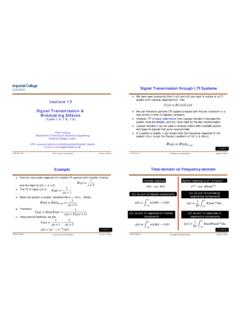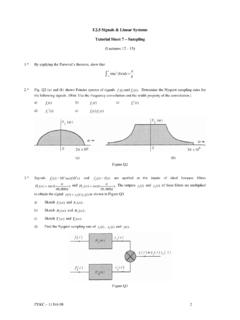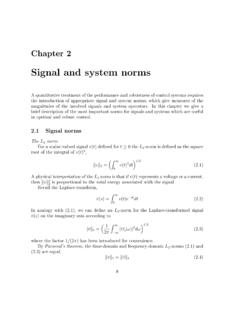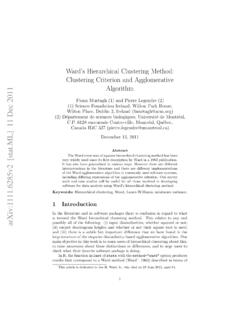Transcription of Mathematical Tools for Physics
1 Mathematical Tools for Physicsby James NearingPhysics DepartmentUniversity of 2003, James NearingPermission to copy forindividual or classroomuse is May, 2010 ContentsIntroductioniiiBibliographyv1 Basic Stuff1 TrigonometryParametric DifferentiationGaussian Integralserf and GammaDifferentiatingIntegralsPolar CoordinatesSketching Graphs2 Infinite Series24 The BasicsDeriving Taylor SeriesConvergenceSeries of SeriesPower series, two variablesStirling s ApproximationUseful TricksDiffractionChecking Results3 Complex Algebra52 Complex NumbersSome FunctionsApplications of Euler s FormulaGeometrySeries of cosinesLogarithmsMapping4 Differential Equations67 Linear Constant-CoefficientForced OscillationsSeries SolutionsSome General MethodsTrigonometry via ODE sGreen s FunctionsSeparation of VariablesCircuitsSimultaneous EquationsSimultaneous ODE sLegendre s EquationAsymptotic Behavior5 Fourier Series100 ExamplesComputing Fourier
2 SeriesChoice of BasisMusical NotesPeriodically Forced ODE sReturn to ParsevalGibbs Phenomenon6 Vector Spaces123 The Underlying IdeaAxiomsExamples of Vector SpacesLinear IndependenceNormsScalar ProductBases and Scalar ProductsGram-Schmidt OrthogonalizationCauchy-Schwartz inequalityInfinite Dimensions7 Operators and Matrices143 The Idea of an OperatorDefinition of an OperatorExamples of OperatorsMatrix MultiplicationInversesRotations, 3-dAreas, Volumes, DeterminantsMatrices as OperatorsEigenvalues and EigenvectorsChange of BasisSummation ConventionCan you Diagonalize a Matrix?
3 Eigenvalues and GoogleSpecial Operators8 Multivariable Calculus179 Partial DerivativesChain RuleDifferentialsGeometric InterpretationGradientElectrostaticsPlan e Polar CoordinatesCylindrical, Spherical CoordinatesVectors: Cylindrical, Spherical BasesiGradient in other CoordinatesMaxima, Minima, SaddlesLagrange MultipliersSolid AngleRainbow9 Vector Calculus 1213 Fluid FlowVector DerivativesComputing the divergenceIntegral Representation of CurlThe GradientShorter Cut for div and curlIdentities for Vector OperatorsApplications to GravityGravitational PotentialIndex NotationMore Complicated Potentials10 Partial Differential Equations242 The Heat EquationSeparation of VariablesOscillating TemperaturesSpatial Temperature DistributionsSpecified Heat FlowElectrostaticsCylindrical Coordinates11
4 Numerical Analysis267 InterpolationSolving equationsDifferentiationIntegrationDiffe rential EquationsFitting of DataEuclidean FitDifferentiating noisy dataPartial Differential Equations12 Tensors294 ExamplesComponentsRelations between TensorsBirefringenceNon-Orthogonal BasesManifolds and FieldsCoordinate BasesBasis Change13 Vector Calculus 2325 IntegralsLine IntegralsGauss s TheoremStokes TheoremReynolds Transport TheoremFields as Vector Spaces14 Complex Variables347 DifferentiationIntegrationPower (Laurent)
5 SeriesCore PropertiesBranch PointsCauchy s Residue TheoremBranch PointsOther IntegralsOther Results15 Fourier Analysis370 Fourier TransformConvolution TheoremTime-Series AnalysisDerivativesGreen s FunctionsSine and Cosine TransformsWiener-Khinchine Theorem16 Calculus of Variations383 ExamplesFunctional DerivativesBrachistochroneFermat s PrincipleElectric FieldsDiscrete VersionClassical MechanicsEndpoint VariationKinksSecond Order17 Densities and Distributions409 DensityFunctionalsGeneralizationDelta-fu nction NotationAlternate ApproachDifferential EquationsUsing Fourier TransformsMore wrote this text for a one semester course at the sophomore-junior level.
6 Our experience withstudents taking our junior Physics courses is that even if they ve had the Mathematical prerequisites,they usually need more experience using the mathematics to handle it efficiently and to possess usableintuition about the processes involved. If you ve seen infinite series in a calculus course, you may haveno idea that they re good for anything. If you ve taken a differential equations course, which of thescores of techniques that you ve seen are really used a lot?
7 The world is (at least) three dimensional so you clearly need to understand multiple integrals,but will everything be rectangular?How do you learn intuition?When you ve finished a problem and your answer agrees with the back of the book or withyour friends or even a teacher, you re not done. The way to get an intuitive understanding of themathematics and of the Physics is to analyze your solution thoroughly. Does it make sense? Thereare almost always several parameters that enter the problem, so what happens to your solution whenyou push these parameters to their limits?
8 In a mechanics problem, what if one mass is much largerthan another? Does your solution do the right thing? In electromagnetism, if you make a couple ofparameters equal to each other does it reduce everything to a simple, special case? When you re doinga surface integral should the answer be positive or negative and does your answer agree?When you address these questions to every problem you ever solve, you do several things. First,you ll find your own mistakes before someone else does.
9 Second, you acquire an intuition about howthe equations ought to behave and how the world that they describe ought to behave. Third, It makesall your later efforts easier because you will then have some clue about why the equations work the waythey do. It reifies the it take extra time? Of course. It will however be some of the most valuable extra time youcan it only the students in my classes, or is it a widespread phenomenon that no one is willing tosketch a graph? ( Pulling teeth is the clich e that comes to mind.)
10 Maybe you ve never been taughtthat there are a few basic methods that work, so look at keep referring to isone of those basic Tools that is far more important than you ve ever been told. It is astounding howmany problems become simpler after you ve sketched a graph. Also, until you ve sketched some graphsof functions you really don t know how they I taught this course I didn t do everything that I m presenting here. The two chapters,Numerical Analysis and Tensors, were not in my one semester course, and I didn t cover all of the topicsalong the way.











